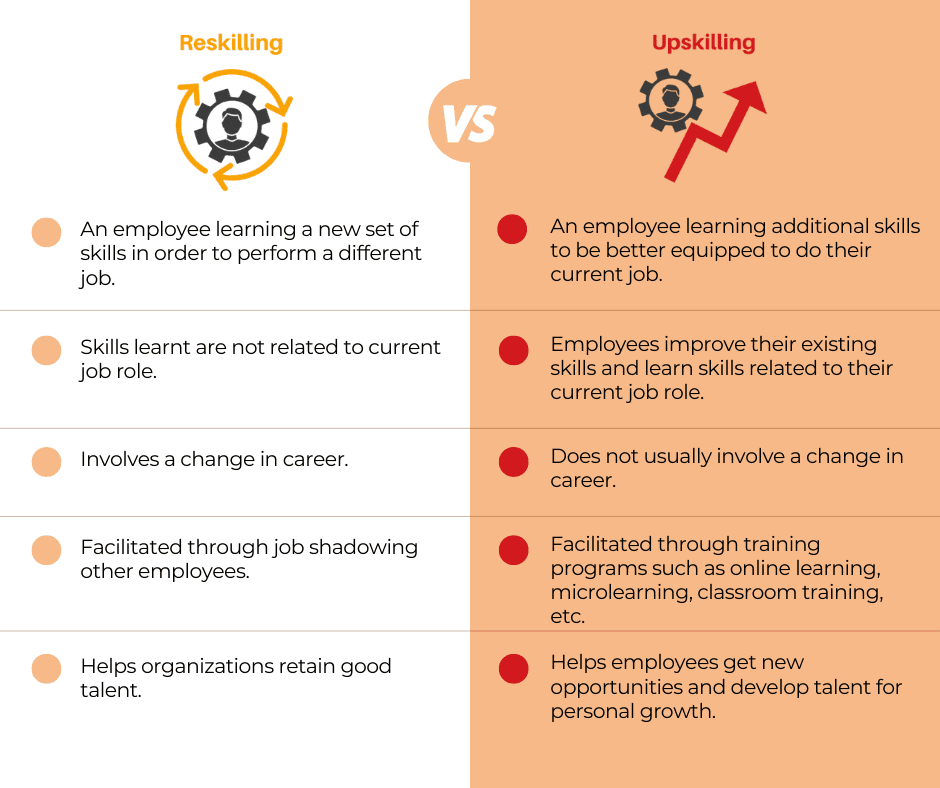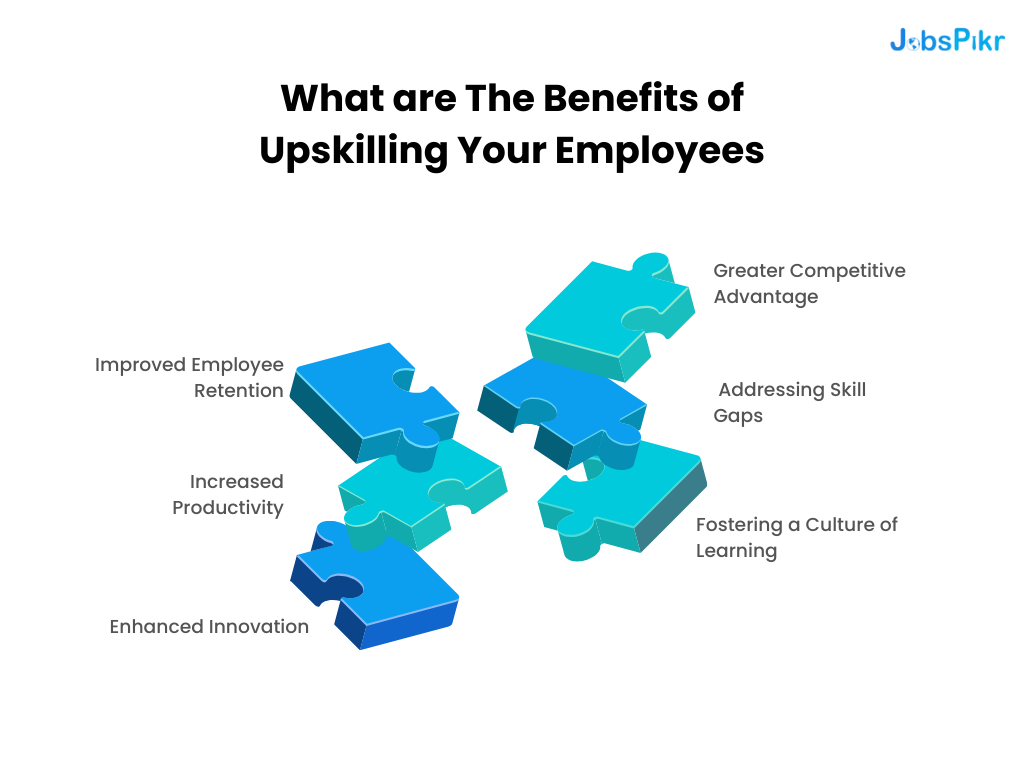The term “upskilling” has gained significant traction in the job market. But what is upskilling? At its core, upskilling refers to the process of teaching employees new skills or enhancing their existing ones to help them keep pace with industry changes and organizational needs. It goes beyond mere training; upskilling involves a strategic approach to workforce development that prepares employees for future challenges, leading to improved employee retention and driving business growth.
What is Upskilling?

Image Source: Naukri
Upskilling is a proactive measure that organizations undertake to equip their employees with the necessary skills to adapt to new technologies, methodologies, and market demands. This process can encompass various forms of learning, including formal education, on-the-job training, online courses, and mentorship programs.
Why is Upskilling Important?

Image Source: CollegeVidya
- Adapting to Change: In an era marked by technological advancements and shifting market dynamics, upskilling allows companies to remain competitive. As industries evolve, the demand for specific skills also changes. Organizations that prioritize upskilling can quickly adapt to these changes, ensuring that their workforce remains relevant.
- Enhancing Employee Engagement: Employees are more likely to feel valued and motivated when they see that their employers are investing in their professional development. This investment fosters a culture of continuous learning, encouraging employees to take ownership of their careers.
- Building a Future-Ready Workforce: Upskilling enables organizations to cultivate a workforce that is not only equipped for current challenges but also prepared for future developments. By anticipating industry trends and providing employees with the tools to meet them, companies can position themselves for long-term success.
What are The Benefits of Upskilling Your Employees?
Investing in upskilling offers numerous advantages for both employees and organizations. Here are some of the key benefits:

1. Improved Employee Retention
One of the most significant advantages of upskilling is its positive impact on employee retention. When employees feel that they are continually learning and developing, they are less likely to seek opportunities elsewhere. Research shows that organizations that invest in employee development experience lower turnover rates.
Moreover, when employees are given the opportunity to grow their skills, they develop a deeper connection to their roles and the organization. This commitment can lead to increased job satisfaction and loyalty, resulting in a more stable workforce.
2. Increased Productivity
Upskilled employees are typically more efficient and effective in their roles. By acquiring new skills, they can perform tasks more proficiently and adapt to changing demands more readily. This heightened productivity can directly contribute to a company’s bottom line, making upskilling a valuable investment.
3. Enhanced Innovation
A skilled workforce is better equipped to innovate. When employees possess a broad range of skills and knowledge, they are more likely to contribute fresh ideas and solutions. Upskilling fosters an environment of creativity and collaboration, which can lead to improved products, services, and processes.
4. Greater Competitive Advantage
In a competitive business landscape, organizations that prioritize upskilling can differentiate themselves from their competitors. A well-trained workforce can respond more effectively to customer needs and market shifts, positioning the company as a leader in its industry. This competitive advantage is crucial for sustaining growth and profitability.
5. Addressing Skill Gaps
As industries evolve, so do the skills required to thrive within them. Upskilling allows organizations to address skill gaps that may exist within their workforce. By identifying areas where employees need further development, companies can tailor their training initiatives to bridge these gaps and enhance overall performance.
6. Fostering a Culture of Learning
Upskilling initiatives contribute to building a culture of learning within an organization. When employees see that their company values professional development, they are more likely to engage in continuous learning. This culture not only benefits individual employees but also contributes to the organization’s overall growth and adaptability.
How to Implement Effective Upskilling Initiatives for Your Team?
To realize the benefits of upskilling, organizations must implement effective strategies. Here are some steps to consider:
1. Conduct a Skills Assessment
Before launching an upskilling program, it is essential to understand the current skill levels of employees and identify any gaps. Conducting a skills assessment can help organizations determine which areas require focus and which skills will be most beneficial for future growth.
2. Set Clear Goals
Establishing clear goals for the upskilling initiative is crucial. Organizations should define what they hope to achieve through upskilling, whether it’s improving employee performance, preparing for technological advancements, or enhancing team collaboration. Having specific objectives will guide the development of training programs and help measure success.
3. Offer Diverse Learning Opportunities
Employees have different learning styles and preferences. To cater to this diversity, organizations should offer a variety of learning opportunities, including online courses, workshops, mentorship programs, and hands-on projects. This variety will increase engagement and ensure that employees can learn in a way that suits them best.
4. Encourage a Growth Mindset
Creating a culture that encourages a growth mindset is vital for the success of upskilling initiatives. Leaders should promote the idea that learning and development are continuous processes and that mistakes are opportunities for growth. This mindset will empower employees to take risks and embrace new challenges.
5. Provide Ongoing Support
Upskilling shouldn’t be a one-time event; it should be an ongoing process. Organizations should provide continuous support and resources to employees as they develop new skills. This support can include access to learning materials, regular check-ins with mentors, and opportunities for practical application of newly acquired skills.
6. Measure Success
To gauge the effectiveness of upskilling initiatives, organizations should establish metrics for success. This could include tracking employee performance improvements, monitoring retention rates, and assessing overall business growth. By measuring the impact of upskilling, organizations can make informed decisions about future training investments.
Conclusion
Upskilling is not just a trend; it is a critical strategy for organizations aiming to improve employee retention and drive business growth. By investing in the continuous development of their workforce, companies can enhance productivity, foster innovation, and build a competitive advantage. In today’s fast-paced business environment, upskilling the workforce is essential for thriving amidst change.
As HR departments look to the future, prioritizing upskilling initiatives will not only benefit employees but will also set the stage for long-term organizational success. By understanding what upskilling is and recognizing its importance, companies can create a motivated, skilled workforce that is ready to tackle the challenges of tomorrow.
Ready to take your upskilling initiatives to the next level? At JobsPikr, we provide the data you need to identify skills in demand, enabling your organization to develop targeted upskilling programs that drive employee retention and business growth. Sign up now.



